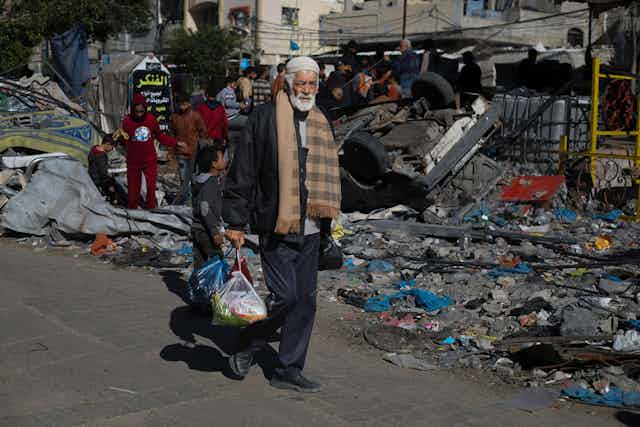So far, the ceasefire between the Israel Defense Forces (IDF) and Hamas, originally set at four days and since extended twice as more hostages and prisoners are exchanged, remains in place. There have been concerns that isolated incidents of violence, including one in Jerusalem where three Israeli civilians were gunned down in an attack claimed by Hamas, might kickstart hostilities once again. But the tenuous pause in the fighting seems, by and large, to be holding.
As a result, aid continues to get into the war-torn Gaza Strip, and the exchange of Israeli hostages taken in the October 7 attacks for Palestinians, most of them women and children held in “administrative detention” in Israel, continues.
In the meantime, we have found out more about the horrors of October 7, including which groups joined Hamas in its killing and kidnapping spree. A BBC report has revealed that five separate armed militias were involved besides Hamas – and that Hamas had trained with up to ten other armed groups prior to the attacks.
Brian Phillips, an expert in international relations at the University of Essex, believes the number of armed groups operating in support of Hamas increases the risk of a breakdown in the ceasefire. Already since the Jerusalem shootings, Itamar Ben-Gvir – one of the more hawkish members of Benjamin Netanyahu’s government – has called for a military response, saying this incident proves he was right to oppose the ceasefire.
Meanwhile, just across the border in Lebanon are 60,000 Hezbollah fighters. There have been some clashes between Hezbollah and Israel’s military, but so far the “Party of God” has not become fully engaged in the current struggle. This, Phillips says, would be a significant escalation as, in addition to its military might, Hezbollah also wields considerable political muscle in Lebanon, so the conflict could quickly morph into a regional war.
But as long as talks continue, the killing will largely remain on hold – or at least, one must hope so. That the two sides are communicating at all is largely down to the mediation of the Qatari government. Qatar has set itself up as a centre for conflict resolution in recent years under the aegis of its emir, Hamad bin Khalifa Al Thani. The country has hosted an array of peace deals in recent years, including the talks between the US and the Taliban which resulted in the US pull-out from Afghanistan in 2021. Qatar also played a role in ending hostilities between Hamas and Israel in 2012.

Gaza Update is available as a fortnightly email newsletter. Click here to get our updates directly in your inbox.
As Vassilis Fouskas, a professor of international politics and economics at the University of East London, explains, Al Thani is the only head of state to have visited Gaza since Hamas took over in 2007. His leadership has provided millions of dollars in aid support to Gaza, as well as allowing Hamas to open an office in Qatar’s capital, Doha. Fouskas writes that as well as the political clout this gives Qatar with Hamas, the small but extremely wealthy Gulf kingdom has also built strong business ties in the west, which gives it access to the US and – through them – to Israel.
Read more: Gaza war: how Qatar used its business connections to become a leading mediator in the Middle East
The extensions to the original four-day truce have been a blessed chance for aid agencies to funnel supplies to the Gazan population, who have been under virtual siege since October 7. But Sarah Schiffling of Hanken School of Economics and Chris Phelan of Edge Hill University, both experts in humanitarian aid management, believe that the amounts of food, fuel and medicine reaching the 2.2 million people in Gaza – most of whom have been displaced – will be far from adequate.
This was confirmed by the UN secretary general, Antonio Gutterez, who said on November 29: “[The aid] remains completely inadequate to meet the huge needs of more than 2 million people.” Schiffling and Phelan also believe the scale of the humanitarian disaster is such that once Israel resumes its assault, the situation could worsen rapidly.
One of the big concerns for humanitarian agencies is that disease will end up being an even bigger killer in Gaza than Israel’s bombardment. The World Health Organization (WHO) recently highlighted that if Gaza’s water supplies and sanitation systems are not repaired very soon, there could be an enormous surge of gastrointestinal and infectious diseases among the local populations – including cholera.
Yara M. Asi, an assistant professor of global health management at the University of Central Florida, writes that the “easy spread of infectious disease in wartime conditions can be just as devastating as airstrikes to health and mortality – if not more so”. She believes that Gaza’s healthcare system, already virtually crippled before October 7, is fast becoming overwhelmed.
Targets and tunnels
Among the more contentious “military targets” have been several of Gaza’s hospitals which, under the rules of war, must be protected from attack. The only exception is when such medical premises are being used for military purposes, which – as we wrote here a fortnight ago – is what Israel has claimed about the al-Shifa hospital, Gaza’s largest, which it raided and searched on November 15.
The IDF published a video showing a tunnel under the hospital which it claimed was evidence of a Hamas command-and-control facility being run from the premises. Jamie Pringle, a reader in forensic geoscience at Keele University, and Alastair Ruffell of Queen’s University Belfast, are both experts at underground forensic detection, and they explain how they would go about searching a facility such as al-Shifa for underground facilities.
Read more: Gaza war: how investigators would go about finding and verifying underground military complexes
Meanwhile, we’ve heard from Prime Minister Netanyahu that the IDF remains poised to resume its assault on Gaza – which, he says, will continue until they have rooted out and destroyed Hamas as a political force. So far, the IDF has reported 75 of its forces have been killed during the ground offensive, but James Horncastle – an expert in international relations from Simon Fraser University in Canada – believes that the more of Gaza Israel destroys, the more difficult its mission becomes. As he observes: “Debris [created by the aerial bombardment] creates natural choke points and fortifications that the defender can use to control the movement of the aggressor.”
Horncastle explains that Hamas fighters will be intimately aware of the terrain on which they are fighting, and have been preparing for this offensive for years. And that Israel has so far only explored a fraction of the estimated 500km of tunnels under Gaza, which allowed Hamas fighters to shelter during the weeks of aerial bombardment that preceded this ground offensive.
Read more: Israel's ground offensive in Gaza City is ignoring the past lessons of urban warfare
Dissent on both sides
As the IDF’s assault has gradually moved south through the Gaza Strip, driving before them hundreds of thousands of refugees desperate to find sanctuary from the violence, there have been reports that some Palestinians are openly expressing defiance of Hamas. Indeed, polling taken in the days before the October 7 attacks found that more than two-thirds of people in Gaza and the West Bank had either little or no confidence in Hamas.
Christoph Bluth, an expert in international relations at the University of Bradford, considers how representative Hamas is of ordinary Palestinians, noting that the most recent election in Gaza was in 2006 and that – given the average age of the population is about 18 – most people won’t have voted for them. Bluth adds that human rights organisations have recorded many instances of arbitrary detention, torture and punishment beatings of Gaza residents by the Hamas authorities, while Hamas also stands accused of harassing journalists who criticise its government.
Read more: Gaza war: how representative is Hamas of ordinary Palestinians?
On the other side of the border fence, Israeli journalists are coming under fire from the Netanyahu government for not toeing the official line. Haaretz, Israel’s most prominent left-leaning daily newspaper, has felt the wrath of the communications minister, Shlomo Karhi, who has suggested financial penalties be applied to the paper while accusing it of publishing “lying, defeatist propaganda” and “sabotaging Israel in wartime”. The proposal aims to cancel state subscriptions to the paper and “forbid the publication of official notices”.
Colleen Murrell, who has worked as a reporter and producer for the BBC and ITN, among others – including a stint in Gaza – and is now a professor of journalism at Dublin City University, charts the way the Israeli authorities are trying to control the message, using heavyhanded tactics first employed by the British during the Palestine Mandate before 1948.
Violence versus humanity
Since October 7 there has been a dramatic uptick in the number of violent incidents in the West Bank, where there are reported to be more than 750,000 Israelis living in 290 illegal settlements. Since the Hamas attacks, the United Nations has recorded 281 settler attacks on Palestinians as of November 29.
Tristan Dunning of the University of Queensland and Martin Kear from the University of Sydney – both experts in the Israeli-Palestinian conflict – report that the 250 deaths caused by this surge in settler violence include 55 children. It doesn’t help that the settlers are being openly encouraged by Israel’s interior minister, Itamar Ben Gvir, who said earlier in the year: “We have to settle the land of Israel and at the same time need to launch a military campaign, blow up buildings, assassinate terrorists. Not one or two but dozens, hundreds or, if needed, thousands.”
Humanity seems to find it hard to heed Martin Luther King’s warning that “hate begets hate, violence begets violence”. Torbjörn Tännsjö, of Stockholm University, gives us a moral philsopher’s view of the conflict, comparing Hamas’s savage attack on October 7 with the brutality of Israel’s response. He remains optimistic that humanity on both sides might prevail, while admitting that, at present, this appears to be a long shot.
Read more: Gaza war: a better understanding of the violence on both sides might give us a chance at a solution
Gaza Update is available as a fortnightly email newsletter. Click here to get our updates directly in your inbox.

